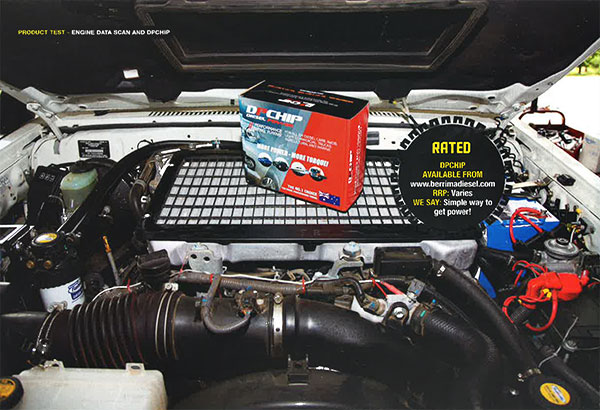-
Your shopping cart is empty!
EVERYONE, it seems, is a self-proclaimed ‘expert’, all too happy to dish out their advice to an open ear (wanted or not). While I’m sure some of the ‘newer’ experts could provide a perfectly good and safe engine performance upgrade, handing over my pride and joy to someone who hasn’t been in the game for long enough to know the ins and outs isn’t something I can do.
Sure, the younger set tend to be more up to date with all things electronic than the older generation, but I still wonder if some young’uns totally understand the ramifications when they go fiddling about with the electronic workings of a common-rail turbo-diesel engine.

Given my own exhaustive research on upping my Troopy engine outputs I’ve gone with the tried and tested, albeit slightly conservative, DPChip. It’s a simple plug-in electronic computer module that has been individually programmed for my vehicle to alter the fuel, timing, boost, pressure and air characteristics for safe, upgraded performance returns across a wider power band. No expensive ECU flash tunes, no fancy remaps and no outlandish claims of clutch-destroying power upgrades. The DPChip module plugs into the existing wiring harness and took Andrew Leimroth of Berrima Diesel only a couple of minutes to install.
Given Berrima Diesel, the creators of the DPChip, have been in the diesel-engine game since 1956 (Reinhard Leimroth was trained by Robert Bosch) and offer a six-year warranty on its power modules, as well as factory-backed driveline warranty and a 60-day money-back guarantee, there’s a lot to be said for assuaging any fears of mystical electronic gremlins causing limp-home modes that we often hear of from other systems.
With the DPChip living downstream of the factory ECU, all engine safety modes are left intact. If something goes wrong then all standard factory engine fault codes will activate, uninterrupted by the mod.
The chip is user-adjustable and can be used to increase power at the expense of fuel usage. However, out-of-the-box settings and improvements are more than adequate. Before and after dyno runs show the DPChip-enhanced Troopy pumping out an extra 106.1Nm at its peak and about 100Nm more across the useable rev range. While the actual percentage increase isn’t quite up to the maximum claims of “up to 25 and 35 per cent”, my engine’s output of 747.5Nm and 131.0kW at the rear wheels - in combination with a three-inch mandrt bent exhaust - has sure made a notabl driving difference.
Before we get into how improved the drive is, we need to understand this is a commercial 4x4 with low gearing, a manual gearbox and low-revving engine; not an auto, high-revving passenger or SUV-type 4x4. Given that, we simply can’t expect to be shaving huge amounts of time off quarter-mile runs. While there is more urgency in the initial acceleration, it’s the added torque that comes into play once you’re up and rolling that has made a huge difference to this Troopy. My roll-on times (60-100km/h and 80-100km/h without changing gears) have improved massively - a result of the higher torque. Being able to hold a higher gear on the freeway, around town and while towing is easily done and is the advantage of having more torque to play with.
As diesel prices rise, so does the importance of fuel consumption. Now that we’ve increased our power output, fuel economy is bound to suffer. From my first five tanks of fuel (at about 500km per tank load) my first tank returned abysmal fuel economy - a reality of about 3.0L/100km worse off (although this may have been more because of my lead foot until the novelty wore off).

After filling the tank twice more, I took a more sensible approach to my driving and allowed the engine to take advantage of the extra torque without over-revving it all the time. No loutish driving and no stomping on the loud pedal at every chance, and I was rewarded with pre-DPChip fuel economy. Using that higher torque at lower revs and in higher gears without over-loading the engine is the only way you’ll achieve improved fuel consumption - despite being less fun.
For my final tank I drove like a grandmother. Forgoing my usual `hurry up and wait’ approach, I dropped back by five to 10km/h, took off gently and got honked a few times by impatient drivers. Despite the indignity of being called a Sunday driver, my resulting fuel consumption of 3.0L/100km better off brought a smile to my face and a welcome reprieve to my hip pocket.
The improved torque at lower revs for towing, easier long-distance touring and similar-to-slightly better fuel economy is great, especially when you consider this isn’t a backyard job liable to destroy your pride and joy.